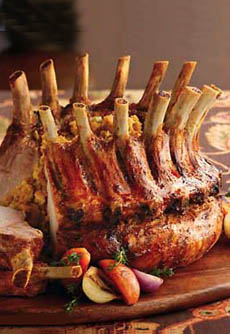RECIPE: Roast Loin Of Pork With Gingered Figs & Jalapeños
|
We grew up in a family so passionate about cooking (or was that obsessive?), that for holiday meals there were at least two of everything: two appetizers, two main courses, and more than two hors d’oeuvre, sides and desserts.
Lacking the energy of our mother, grandmother and aunt, we’d planned only one main course for Easter dinner: a family favorite, classic roast leg of lamb with mint jelly. Then, we received this very contemporary recipe for a fancy pork roast. The lavender, gingered figs and jalapeños turned our heads. So the pork loin is joining the lamb leg on the Easter table. The recipe was created by Jan Birnbaum, executive chef of Epic Roadhouse restaurant in San Francisco (it has a great view of the Bay Bridge) and typically serves eight people. In the case of a companion leg of lamb, it can serve many more—or promise several days of delicious leftovers. |
Flavorful pork loin, sliced and plated. Photo courtesy Epic Roadhouse | San Francisco. |
|
|
The gingered figs can be prepared up to 10 days in advance. In fact, making them at least five days in advance allows the figs to develop the best flavor. RECIPE: LAVENDER PORK LOIN WITH GINGERED FIGS, CALIFORNIA RAISINS & Ingredients For The Pork Loin
Ingredients For Sauce & Garnish |
||
 The frenched loin of pork. Photo courtesy AllenBros.com. |
Ingredients For The Potatoes |
|
|
Preparation
1. MAKE GINGERED FIGS. Place ginger, allspice berries and black pepper corns in a sachet. Combine with the honey, sugar, water, lime and lemon juices in a heavy, nonreactive pot (see discussion below about reactive vs. nonreactive cookware). Bring to a gentle boil and simmer until the liquid begins to become syrup-like; do not over-reduce. Prep the figs by placing a skin deep “X” on the flower end. Place the figs in a steel pan submerged halfway in ice with some water. Pour the hot liquid over the figs. Refrigerate for up to 10 days. 2. THE NIGHT BEFORE the dinner, combine garlic, lavender, rosemary, thyme, olive oil and mustard. Marinate the pork in this mixture overnight. The following day… 3. BLANCH the potatoes in salted water until creamy in center, cool and cut in half. Toss the potatoes with the olive oil, garlic cloves in their skins, chopped rosemary and melted butter. Season to taste with salt and pepper. Reserve. 4. PREHEAT the oven to 375°F. In a skillet, heat the olive oil and sear the pork over medium high heat. Remove to roasting pan and place in oven. After 20 minutes, add the potatoes cut side down with the garlic cloves and herbs. Allow to roast for 20 more minutes or until internal temperature of pork reaches 140°F. Remove from oven. Remove roast from pan and allow to rest on cutting board at room temperature, covered with a clean kitchen towel. 5. REMOVE excess fat from the pan and sauté the jalapeños on the stove top in the roasting pan, over medium heat for 2 minutes. Add the red wine to deglaze pan. Reduce wine until nearly dry. Add raisins, cut figs in half and add them. Simmer for 5 minutes then gently whisk in butter so as not to damage the figs. Adjust salt and pepper. 6. TO SERVE: Spoon potatoes onto a large platter; slice the chops at each bone and place on top of potatoes. Spoon the figs, raisins and sauce over the entirety. Sprinkle with freshly chopped parsley. Reactive cookware—pots and pans—are made of metals that can react with acidic foods (tomato sauce, for example), creating metallic flavors and the discoloration of lighter foods. Non-reactive cookware doesn’t do this, but it typically doesn’t conduct heat as quickly or uniformly (reactive aluminum is second only to reactive copper in ability to conduct heat). The most ubiquitous cookware, stainless steel, is nonreactive but does not conduct or retain heat well. Good stainless cookware has aluminum or copper bonded to the bottom (or sandwiched in-between stainless layers) to combine the non-reactive surface with rapid, uniform heat conductivity.
|
||



